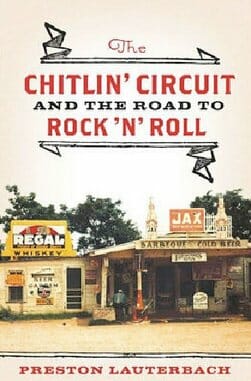The Chitlin’ Circuit and the Road to Rock ’n’ Roll by Preston Lauterbach
Your Chitlin’ Heart

Elvis Presley, goes the myth, invented rock ’n’ roll at Sun Studios, around the time he recorded Arthur “Big Boy” Crudup’s “That’s All Right” in 1954. Without dismissing Presley’s considerable accomplishments—not to mention those of Sam Phillips, Bill Black, and Scotty Moore—the truth of R&R’s origins is much more complicated … and thornier.
Rock ’n’ roll, vital ’n’ powerful, could not have been created out of thin air. Instead, generations of black (and later white) musicians who worked in traveling pop orchestras cultivated it, emphasizing melodic volatility and onstage excitability as they went. They blazed through the network of black-owned nightclubs and venues around the South and Midwest known as the Chitlin’ Circuit, honing their chops, paring down their rosters, and upping the ante with each show. Presley’s debut single itself developed on the Chitlin’ Circuit nearly a decade before the man who would be the King released it.
If the music played in Chitlin’ Circuit clubs, which ranged from fire-hazard structures outside small towns to opulent stages in larger cities, proved essential to the creation of rock ’n’ roll, it stands the test of time in its own right. It’s far from simply a waystation to a largely white idiom.
Even so, the Chitlin’ Circuit remains largely unexamined and unheralded, its very definition somewhat vague—there’s nothing resembling official membership and little documentation of goings-on in venues. All this makes The Chitlin’ Circuit and the Road to Rock and Roll crucial to our understanding of late-20th-century pop music and all the more impressive for its exhaustive research. Preston Lauterbach’s book—spirited, studious, surprising, occasionally hilarious—is absolutely persuasive on its subject.
Who got a start on the Chitlin’ Circuit? It might be more expedient to ask who didn’t. Lauterbach follows the travels and travails of Joe Turner, Louis Jordan, Clarence “Gatemouth” Brown, Wynonie Harris, Little Richard, and James Brown, among many. Some memorable personalities, however, have largely and perhaps unfairly been forgotten, even after exerting an indelible influence on subsequent generations. Jimmie Lunceford may not be a household name, but he routinely performed at Memphis high schools in the 1940s and 1950s. He helped establish an atmosphere, if not a curriculum, that inspired Isaac Hayes, Willie Mitchell, Booker T. Jones, and many other ’60s musicians.
-

-

-

-

-

-

-

-

-

-

-

-

-

-

-

-

-

-

-

-

-

-

-

-

-

-

-

-

-

-

-

-

-

-

-

-

-

-

-

-








































